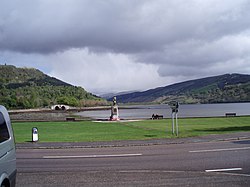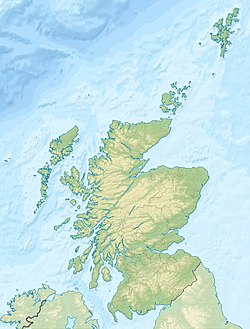This section needs additional citations for verification. (August 2022) |
Glen Shira (Gaelic: Gleann Siara, "Glen of the eternal river") is a glen in Argyll and Bute, west of Scotland, at the northern end of Loch Fyne, just to the north of Inveraray. It is a Special Area of Conservation within the UK, bordered by Beinn Bhuidhe on the Glen Fyne side.
Glen Shira
Gleann Siara (Scottish Gaelic) | |
|---|---|
Glen | |
 Inveraray facing north towards the glen mouth. | |
| Coordinates: 56°17′06″N 05°01′01″W / 56.28500°N 5.01694°W | |
| Grid position | NN 13349 14374 |
| Location | Argyll and Bute, Scotland |
| Native name | Gleann Siara (Scottish Gaelic) |
Glen Shira is named after the River Shira, which runs through the centre of the glen.[1] The river starts to the northeast at 350 metres elevation, near the start of the River Fyne. Shira runs into the 5 MW Sròn Mòr (Big Nose) power station dam,[2] and then for about seven miles (eleven kilometres) down to and through Loch Dubh (Black Lake) at the base. From there, the waters flow into Loch Shira, a small inlet on Loch Fyne that, in turn, lends its name to the MV Loch Shira ferry.
The glen is mostly taken up by a resident's sheep farm, but there are numerous houses within the glen, including Elrigbeg (Eileirig Beag), Elrig More (Eileirig Mór), Kilblaan and Drimlee (at the northern end). There is one single-track road which leads up the glen to the dam. This road splits into an access road (connected across the River Shira by a bridge) which leads to Drimlee.
Asda also once produced a whisky called Glen Shira, although this had no connection to the actual glen.
Rob Roy MacGregor
editRob Roy MacGregor lived in Glen Shira for a short time under the protection of John Campbell, 2nd Duke of Argyll,[3] also known as Red John of the Battles (Iain Ruaidh nan Cath). Argyll negotiated an amnesty and protection for Rob in 1716, and granted him permission to build a house in upper Glen Shira after disarmament.
Records suggest that Rob Roy also constructed a fank for sheep or cattle in the Glen. However, some time after the 1719 Jacobite Rebellion — likely around 1720 — Rob moved to Monachyle Tuarach by Loch Doine, abandoning the structures. Nevertheless, ruins remain extant.
Gallery
edit-
Glen Shira
-
Glen Shira
-
Rob Roy MacGregors house in Glen Shira
-
General Wade's bridge near Glen Shira
References
edit- ^ "Glen Shira: Overview". Gazetteer for Scotland. Retrieved 9 August 2022.
- ^ "Power from the Glens" (PDF). Scottish and Southern Energy. p. 23. Archived from the original (PDF) on 18 October 2007. Retrieved 1 August 2008.
- ^ "Robert (Rob Roy) MacGregor 1671 - 1734". Gazetteer for Scotland. Retrieved 9 August 2022.
Sources
edit- W.H. Murray, Rob Roy MacGregor, His Life and Times, Conongate Books Ltd., 3rd ed. (1996).
External links
edit- Map sources for Glen Shira
